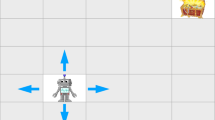Abstract
Recent advances in machine learning, such as deep neural networks, have caused a huge boost in many different areas of artificial intelligence and robotics. These methods typically require a large corpus of well-prepared and labelled training data, which limits the applicability to robotics. In our opinion, a fundamental challenge in autonomous robotics is to design systems that are simple enough to solve simple tasks. These systems should grow in complexity step by step and more complex models like neural networks should be trained by re-using the information acquired over the robot’s lifetime. Ultimately, high-level abstractions should be generated from these models, bridging the gap from low-level sensor data to high-level AI systems. We present first steps into this direction and analyse their limitations and future extensions in order to achieve the goal of designing autonomous agents.
Zusammenfassung
Jüngste Fortschritte im maschinellen Lernen, wie tiefe Neuronale Netze, haben einen großen Schub in vielen verschiedenen Bereichen der Künstlichen Intelligenz und Robotik bewirkt. Diese Methoden erfordern in der Regel einen großen Stamm an gut aufbereiteten Trainingsdaten, welche die Anwendbarkeit der Robotik begrenzen. Unserer Meinung nach ist es eine grundlegende Herausforderung in der autonomen Robotik, Systeme zu entwerfen, die einfach genug sind, um einfache Aufgaben zu lösen. Diese Systeme sollten dann Schritt für Schritt an Komplexität zunehmen. Komplexere Modelle, wie Neuronale Netze, sollten schließlich durch das Auswerten der über die Zeit gewonnenen Informationen laufend weiter trainiert werden. Letztendlich sollten aus diesen Modellen hochrangige Abstraktionen generiert werden, die gewisse fehlende Informationen von Low-Level-Sensordaten hin zu High-Level-Systemen der Künstlichen Intelligenz überbrücken können. Die Autoren stellen erste Schritte in diese Richtung vor und analysieren die Grenzen bzw. künftigen Erweiterungen mit dem Ziel, autonome Agenten zu entwerfen.


Similar content being viewed by others
Explore related subjects
Discover the latest articles, news and stories from top researchers in related subjects.References
Aristotle (−369 BC): Theaetetus.
Asada, M., Hosoda, K., Kuniyoshi, Y., Ishiguro, H., Inui, T., Yoshikawa, Y., Ogino, M., Yoshida, C. (2009): Cognitive developmental robotics: a survey. IEEE Trans. Auton. Ment. Dev., 1(1), 12–34. doi:10.1109/TAMD.2009.2021702.
Briegel, H. J., De las Cuevas, G. (2012): Projective simulation for artificial intelligence. Sci. Rep., 2, 400, EP
Fukushima, K. (1988): Neocognitron: a hierarchical neural network capable of visual pattern recognition. Neural Netw., 1(2), 119–130.
Hangl, S., Dunjko, V., Briegel, H., Piater, J. H. (2017): Skill learning by autonomous robotic playing using active learning and creativity. CoRR. 1706.08560.
Hangl, S., Stabinger, S., Piater, J. (2017): Autonomous skill-centric testing using deep learning. In IEEE/RSJ international conference on intelligent robots and systems.
Hangl, S., Ugur, E., Szedmak, S., Piater, J. (2016): Robotic playing for hierarchical complex skill learning. In IEEE/RSJ international conference on intelligent robots and systems.
Hubel, D. H., Wiesel, T. N. (1968): Receptive fields and functional architecture of monkey striate cortex. J. Physiol., 195(1), 215–243.
Izhikevich, E. M. (2003): Simple model of spiking neurons. IEEE Trans. Neural Netw., 14(6), 1569–1572.
Kahn, G., Villaflor, A., Pong, V., Abbeel, P., Levine, S. (2017): Uncertainty-aware reinforcement learning for collision avoidance. CoRR. 1702.01182.
LeCun, Y., Bengio, Y., Hinton, G. (2015): Deep learning. Nature, 521(7553), 436–444.
Levine, S., Pastor, P., Krizhevsky, A., Ibarz, J., Quillen, D. (2017): Learning hand-eye coordination for robotic grasping with deep learning and large-scale data collection. Int. J. Robot. Res., doi:10.1177/0278364917710318
Lungarella, M., Metta, G., Pfeifer, R., Sandini, G. (2003): Developmental robotics: a survey. Connect. Sci., 15(4), 151–190.
McCarthy, J., Minsky, M. L., Rochester, N., Shannon, C. E. (1955): A proposal for the Dartmouth summer research project on artificial intelligence. AI Mag., 31(4), 12. 27, 2006.
Piaget, J. (1952): The origins of intelligence in children. New York: Norton.
Sadeghi, F., Levine, S. (2017): Cad2rl: real single-image flight without a single real image. In Robotics: science and systems.
Schmidhuber, J. (2015): Deep learning in neural networks: an overview. Neural Netw., 61, 85–117.
Silver, D., Huang, A., Maddison, C. J., Guez, A., Sifre, L., Van Den Driessche, G., Schrittwieser, J., Antonoglou, I., Panneershelvam, V., Lanctot, M., et al. (2016): Mastering the game of go with deep neural networks and tree search. Nature, 529(7587), 484–489.
Stoytchev, A. (2009): Some basic principles of developmental robotics. IEEE Trans. Auton. Ment. Dev., 1(2), 122–130.
Sutton, R. S. (2001): Verification, the key to AI. Online essay. http://www.cs.ualberta.ca/sutton/IncIdeas/KeytoAI.html.
Tobin, J., Fong, R., Ray, A., Schneider, J., Zaremba, W., Abbeel, P. (2017): Domain randomization for transferring deep neural networks from simulation to the real world. CoRR. 1703.06907.
Turing, A. M. (1950): Computing machinery and intelligence. Mind, 59(236), 433–460.
Ugur, E., Piater, J. (2015): Bottom-up learning of object categories, action effects and logical rules: from continuous manipulative exploration to symbolic planning. In IEEE international conference on robotics and automation, ICRA (S. 2627–2633). New York: IEEE Press.
Weng, J. (2004): Developmental robotics: theory and experiments. Int. J. Humanoid Robot., 1(02), 199–236.
Yu, W., Liu, C. K., Turk, G. (2017): Preparing for the unknown: Learning a universal policy with online system identification. CoRR. 1702.02453.
Author information
Authors and Affiliations
Corresponding author
Rights and permissions
About this article
Cite this article
Hangl, S., Ugur, E. & Piater, J. Autonomous robots: potential, advances and future direction. Elektrotech. Inftech. 134, 293–298 (2017). https://doi.org/10.1007/s00502-017-0516-0
Received:
Accepted:
Published:
Issue Date:
DOI: https://doi.org/10.1007/s00502-017-0516-0
Keywords
- autonomous robots
- cognitive robotics
- developmental robotics
- lifelong learning
- robot creativity
- robot playing




